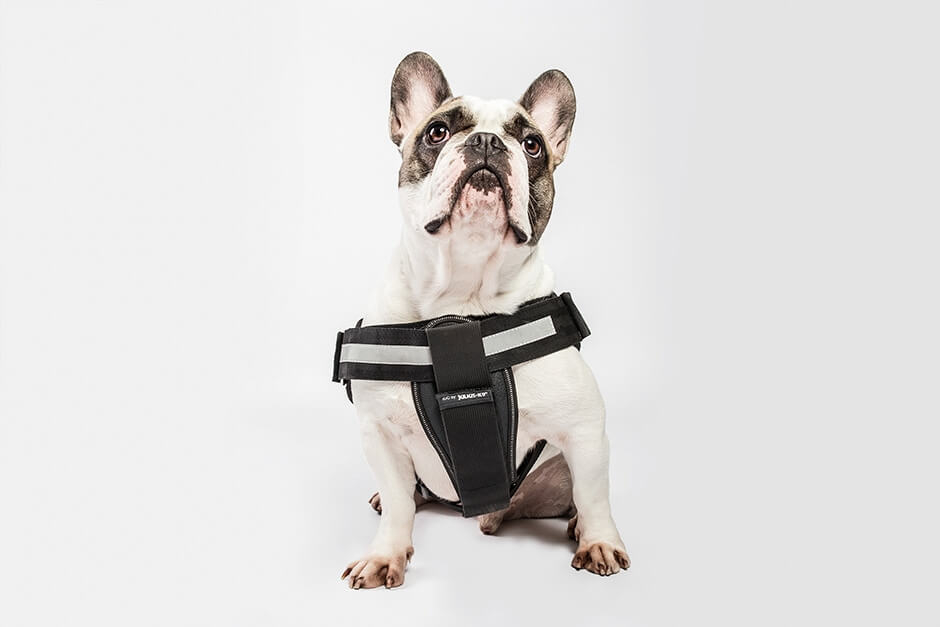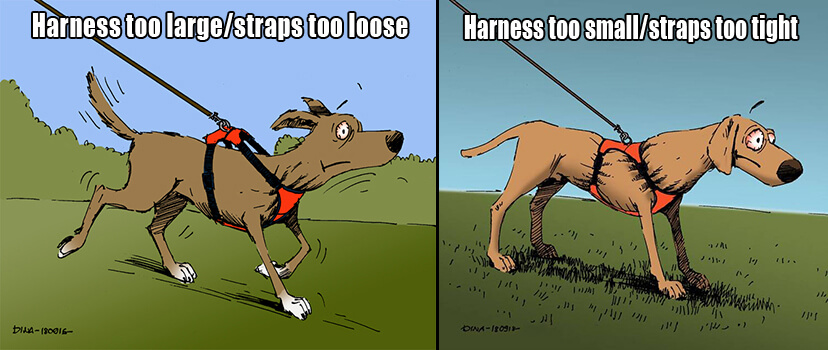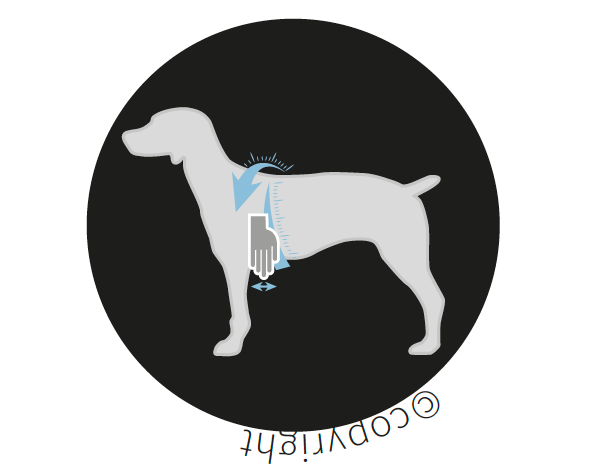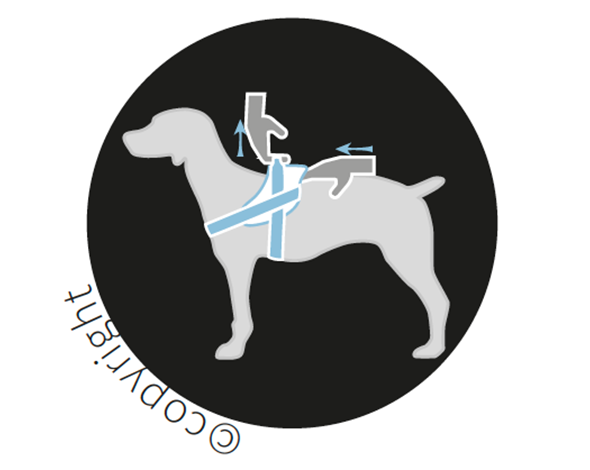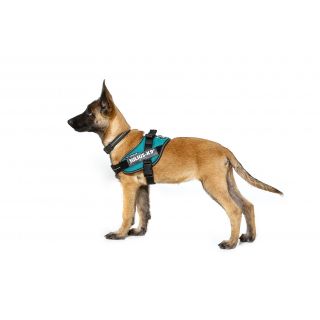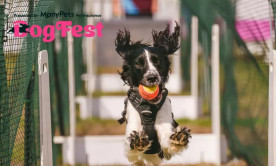In this article:
- Dangers of an improper fitted harness
- Ensuring you have the correct harness size
- Do you have the right harness?
- Reasons why dogs escape from harnesses
- Get familiar with the harness
- Notes for different breeds and body shapes
- Attachable chest pads and belly straps
Making sure you have the perfect harness for your pet can take some time to research. So once you’ve decided on a suitable harness for your dog it’s important to make sure it’s the right size and is adjusted correctly.
An incorrectly fitted harness can do a lot more harm than good, and getting it fitted properly will help keep your dog safe, comfortable, and under control.
Whatever harness you have bought, reputable manufacturers will include printed illustrations with guidelines instructing how best to successfully fit and adjust their harnesses. However, sometimes these instructions can confuse owners.
In this article we will hopefully make it clearer to what exactly you should and shouldn’t do when fitting a harness.
Dangers of an improper fitted harness
A well fitted harness is completely safe and offers comfort, ease of handling, and improved safety when out for walks. However, like any piece of safety equipment, an incorrect fit can be problematic.
An improperly sized or fitted harness can cause a wide range of health and safety issues for your dog:
Too Loose
- This can cause friction and rubbing and general discomfort.
- The chest strap can slip down around the dog’s legs allowing the dog to step out of the harness and escape.
- Pressure of leash pulling will not be evenly distributed around the torso as designed, causing too much force applied to the chest area.
- Risk of chest and neck injuries due to improper support being provided.
- Leash control will be reduced due to poor pressure distribution.
Too Tight
- Breathing can be impeded and can lead to gagging or choking when leash pressure is applied.
- General discomfort felt by the dog.
- Skin and fur irritation caused by friction which can develop into sores.
- It can impact ease walking or running.
Ensuring you have the correct harness size
When buying a new harness, taking accurate measurements of your dog is essential to get the right size.
If you already own a harness but are having problems fitting it or the dog seems uncomfortable, you should check you do actually have the right size harness. A common mistake is not buying a larger harness in time as the dog grows.
You should use both the girth measurement and the weight of the dog.
Girth
When measuring your dog’s girth, you need to use a fabric tape measure and wrap it over your dog's shoulders directly behind the front legs, and wrap it round (image below):
Weight
The simplest way to weigh your dog is to weigh yourself on bathroom scales, then hold your dog and weigh yourself and your dog, and then subtract your weight. This will give you an accurate weight of your dog.
PDSA have a handy video on how best to do this:
Do you have the right harness?
If you no longer have the harnesses documentation that recommends compatible girth measurement and weight, the below table for our IDC Powerharnesses® is a good guide.
Please keep in mind that harnesses from different manufactures will have slightly different size standards.
Size Guide
| IDC® Powerharness Size | Chest Girth Measurement | Dog Weight |
|---|---|---|
| Baby 1 | 29 - 36 cm | 0.8 - 3 kg |
| Baby 2 | 33 - 45 cm | 2 - 5 kg |
| Mini-Mini | 40 - 53 cm | 4 - 7 kg |
| Mini | 49 - 67 cm | 7 - 15 kg |
| 0 | 58 - 76 cm | 14 - 25 kg |
| 1 | 63 - 85 cm | 23 - 30 kg |
| 2 | 71 - 96 cm | 28 - 40 kg |
| 3 | 82 - 115 cm | 40 - 70 kg |
| 4 | 96 - 138 cm | 70 - 90 kg |
Safety Note: Choosing a larger harness for a dog to grow into should be avoided.
This can cause the same safety issues raised above as the designed pressure points for dog lead pulling will be misaligned and the chest strap can slip down over the dog’s front legs, allowing the dog to escape.
Reasons why dogs escape from harnesses
Improper fitting is the main reason why dogs are sometimes able to escape from a harness.
A well fitting harness should be snug but not tight and should allow enough room for you to fit your fingers between the dog’s back and the harness (image below).
Our brief but detailed video on to correctly fit the IDC Powerharness® offers a good guide on how any harness should be fitted whatever the brand.
Correct Harness Fitting
For even more detailed information on correct fitting and adjustment instructions, read our harness measuring guide.
Get familiar with the harness
A good harness should be highly secure for the dog, but very easy for the owner to take off and adjust.
You should be confident in how your harness works and be able to tighten or loosen the it while it’s fitted on your dog.
It’s important to be completely familiar adjusting and using the harness when out for walks in case a dog gets snagged or runs into any difficulty and needs to be released quickly from the harness.
With any new harness, many dogs will need to get comfortable wearing it and getting it fitted, so some harness training may be required. YouTube channel Dog Training by Kikopup has a great video on how best to do this:
This training also goes for the owner. Most harnesses come with clear manufacturer guidelines (all of our harnesses come with specific instructions).
While at home take the time to become familiar with all of the harness features and get used to fitting, adjusting, and removing the harness so you can use it confidently and correctly.
Notes for different breeds and body shapes
- Long bodied dogs, such as Dachshunds, require a harness that allows the leash ring to sit on the middle third of the dog’s body.
- Short bodied dogs with wide girths, such as Pugs, should have the leash attached to the front third of the body.
- The width of the straps running in front of the chest and under the belly is crucial when it comes to pressure load, as a narrower strap puts a higher load on the body of the dog.
- The best answer is to use a 40 – 50 mm strap for dogs weighing more than 18 kg.
- Even for dogs that weigh just a few kilograms, do not use straps that measure less than 14 mm.
- A wide chest strap is the best way to ensure even load distribution.
Attachable chest pads and belly straps
Many harness brands, including our IDC Powerharness®, allow you to add additional safety and comfort features like chest pads and front lead attachment straps. We highlight some of these accessories below:
- You can adjust the fitting of a harness by adding attachable chest pads to the chest strap. These pads come in various sizes so it’s important to select the correct size. For example, a chest pad covering the chest of an English Bulldog is likely to be too big for a Hungarian Pointer.
- A chest pad does not need to fully cover the front of a dog’s chest for normal activities. Over-sized chest pads can create an extra weight load for a dog, especially if they get wet.
- Belly lining pads and straps are helpful for picking up your dog or lifting a dog into your car, but they are prone to getting water logged and muddy.
- With older dogs and dogs with restricted movement, it can be worth using a chest pad with an added handle. This can be useful for lifting the animal, and also for guiding through crowds or beside busy roads.
- Y-Belt Chest Straps offer greater chest support and are useful if dogs are wearing a harness over long periods.
- Easily stressed or anxious dogs are better suited to a chest harness that can be easily put on once they are spooked. Y-Harness designs are best avoided in these cases as they need to be pulled over the dog’s legs, and they often have several buckles.
